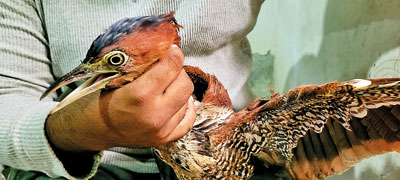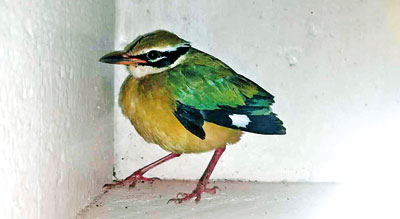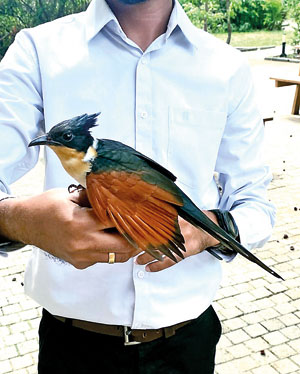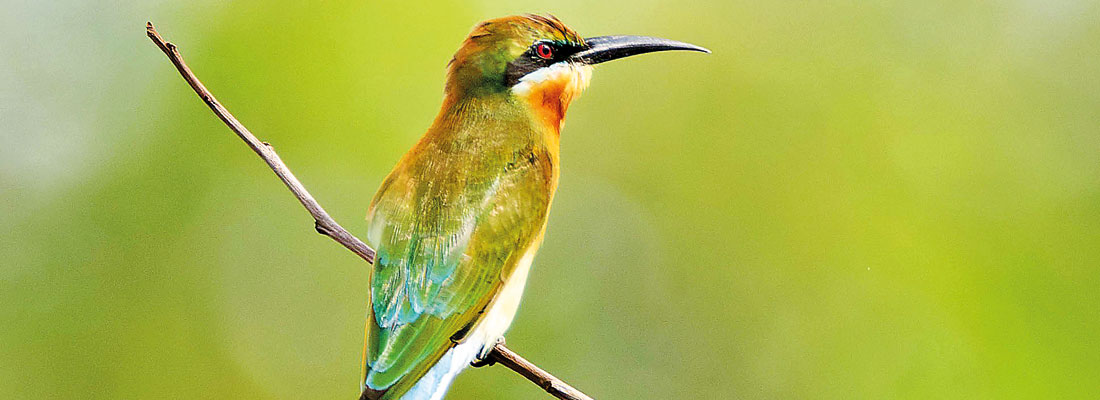News
They are back: Watch out for the exhausted that need help
View(s):
The Malayan Night Heron was found in Avissawella on October 26 with signs of exhaustion and injuries. Pic by Chamindu Kanishka.
By Malaka Rodrigo
The season of migratory birds has begun in Sri Lanka, bringing an array of colourful visitors from across Asia and Europe. Over the past week, there have been several reports of exhausted migratory birds struggling to complete their journey.
In one striking case from Kalubowila, an Indian Pitta (Pitta brachyura) a bird known for its vibrant plumage entered a house, clearly exhausted from its long flight. On another occasion on October 22, a Chestnut-winged Cuckoo (Clamator coromandus) was found almost in a state of collapse due to exhaustion in front of well known environmentalist Srilal Mittapala while he was in Mannar. The bird later took flight after it recovered from exhaustion under protective hands.
On October 26, Chamindu Kanishka found a migratory Malayan night heron (Gorsachius melanolophus) in Avissawella. The bird was hanging around a garden exposed to threat of predators showing signs of difficulties in flying. Mr.Kanishka took him home and tried to feed it as one of its wings seemed damaged.

An exhausted Indian Pitta found in Hatton on October 21. Pic by Nirosha Abeysinghe
Similar sightings have been reported across the country, reminding us of the challenges these tiny travellers face.
“During October and November, many wounded or exhausted birds are brought to the Wild Animal Rescue Centre in Attidiya, which is managed by the Department of Wildlife Conservation (DWC),” says its former veterinary surgeon Dr. Suhada Gunawardena. If it is too weak to fly, try giving it small amounts of low-concentrated glucose saline with Vitamin C if they are conscious, Dr. Gunawardena advised. If the bird is able to fly, release it as soon as possible in a safe environment, he said.
The Indian Pitta is particularly notable during this season, often arriving in the latter part of October. Its frequent appearance, coupled with reports of exhaustion, is a result of the strenuous migratory journey it undertakes across the Indian subcontinent. Migratory birds like the pitta and the cuckoo often fly hundreds of kilometres without rest, crossing oceans, mountains, and urban landscapes, which can leave them vulnerable to fatigue, adverse weather and predation.
For bird lovers and the public, it is important to know how to respond if one comes across an exhausted bird. Do not attempt to feed it or force it to fly immediately. Instead, gently place the bird in a safe, quiet spot, sheltered from predators such as cats, dogs, and crows. Observe it for signs of recovery and only intervene if the bird appears injured or unable to recover on its own. In such cases, contact the Department of Wildlife Conservation (DWC) rescue centre for guidance or hand the bird over to trained personnel. A safe release can be carried out once the bird regains strength, ideally in a location free of predators.

An exhausted Chestnut-winged Cuckoo was found fallen in Mannar around noon on October 22. Pic by Srilal Miththapala
Exhaustion during migration is a natural but serious phenomenon. Birds like the Indian Pitta, Chestnut-winged Cuckoo, and other long-distance migrants expend enormous energy flying thousands of kilometres. Factors such as adverse weather, urbanisation, habitat loss, and light pollution can exacerbate fatigue, increasing the likelihood of exhausted birds appearing in gardens, homes, and roadsides. Some species are more frequently sighted because they undertake longer or more challenging routes, making them more susceptible to exhaustion during this critical time.
Earlier this month, Migratory Bird Day was celebrated in Sri Lanka on October 11, highlighting the importance of these seasonal visitors and the role people can play in their survival. The theme this year emphasised “Shared Spaces: Creating Bird-Friendly Cities and Communities”, stressing the importance of green spaces inside cities for the survival of the migratory birds.

Kimbulawela jogging track October 26: The Blue-tailed Bee eater is one of the common and first magratory arrivals. Pic by Priyanath Kotalawela
The best way to say that you found the home of your dreams is by finding it on Hitad.lk. We have listings for apartments for sale or rent in Sri Lanka, no matter what locale you're looking for! Whether you live in Colombo, Galle, Kandy, Matara, Jaffna and more - we've got them all!

